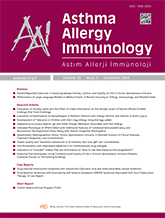


Objective: Immunoglobulin Replacement Therapy (IgRT) via intravenous (IVIG) or subcutaneous (SCIG) routes is essential for managing a large proportion of inborn errors of immunity (IEI), offering reductions in infection rates and enhancements in Health- Related Quality of Life (HRQoL) and treatment satisfaction (TS). The assessment of HRQoL and TS among a diverse spectrum of both pediatric and adult IgRT-receiving IEI patients currently needs to be expanded. The aim of this study was to investigate both HRQoL and treatment satisfaction with current clinical status in a heterogeneous group of patients with IEI receiving IVIG and SCIG.
Materials and Methods: We conducted a cross-sectional survey targeting IEI patients on IgRT, assessing TS (TSQM-9) and HRQoL (KINDL/SF-36). The survey integrated patient and caregiver perspectives with demographic, clinical, safety, and efficacy data to identify confounders of outcomes.
Results: Eighty IEI patients (ages 1-45; 55 females, 45 males) participated, with 71.2% receiving IVIG and 28.8% SCIG. HRQoL scores were significantly higher for the SCIG group compared to IVIG (p=0.006), and even more so at the 20% SCIG concentration (p=0.026). History of adverse reactions to IgRT and diagnostic delay over one year showed lower TSQM-9 scores (p=0.044 and p=0.009, respectively). Patients with comorbidities also reported lower HRQoL and TSQM-9 scores compared to their peers without comorbidities (p=0.012 and p=0.046, respectively).
Conclusion: SCIG, particularly at high concentration, shows an improvement in HRQoL outcomes, whereas adverse reactions to IgRT and diagnostic delay impair TS. Detrimental effect of IEI-related comorbidities on HRQoL and TS highlighted the critical role of timely and accurate diagnosis in IEI management.